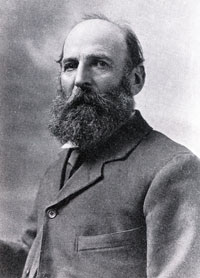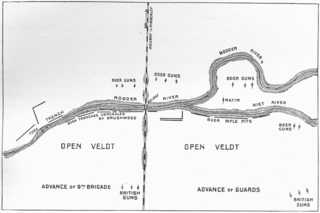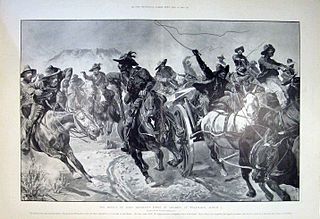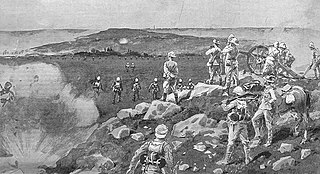
The Second Boer War, also known as the Boer War, the Anglo–Boer War, or the South African War, was a conflict fought between the British Empire and the two Boer Republics over the Empire's influence in Southern Africa from 1899 to 1902.

The First Boer War, was fought from 16 December 1880 until 23 March 1881 between the United Kingdom and Boers of the Transvaal. The war resulted in a Boer victory and eventual independence of the South African Republic. The war is also known as the First Anglo–Boer War, the Transvaal War or the Transvaal Rebellion.

Jacobus Herculaas de la Rey, better known as Koos de la Rey, was a South African military officer who served as a Boer general during the Second Boer War. De la Rey also had a political career and was one of the leading advocates of Boer independence.
Black Week refers to the week of Sunday 10 December – Sunday 17 December 1899 during the Second Boer War, when the British Army suffered three devastating defeats by the Boer Republics at the battles of Stormberg on Sunday 10 December, Magersfontein on Monday 11 December and Colenso on Friday 15 December 1899. In total, 2,776 British soldiers were killed, wounded and captured during this period.

Battle of Schuinshoogte, also known as Battle of Ingogo, was fought north of Newcastle, KwaZulu-Natal, on 8 February 1881 during the First Boer War. General Sir George Pomeroy Colley's communications with Newcastle were under constant harassment by mounted Boer patrols under Commander J D Weilbach after the Battle of Laing's Nek and as a result he planned to clear a path along the Newcastle-Mount Prospect road to better protect the British supply line, and receive fresh reinforcements he needed to bolster his ranks.

The Battle of Laing's Nek was a major battle fought at Laing's Nek during the First Boer War on 28 January 1881.

The Battle of Modder River was an engagement in the Boer War, fought at Modder River, on 28 November 1899. A British column under Lord Methuen, that was attempting to relieve the besieged town of Kimberley, forced Boers under General Piet Cronjé to retreat to Magersfontein, but suffered heavy casualties altogether.

The Battle of Colenso was the third and final battle fought during the Black Week of the Second Boer War. It was fought between British and Boer forces from the independent South African Republic and Orange Free State in and around Colenso, Natal, South Africa on 15 December 1899.

The Battle of Magersfontein was fought on 11 December 1899, at Magersfontein, near Kimberley, South Africa, on the borders of the Cape Colony and the independent republic of the Orange Free State. British forces under Lieutenant General Lord Methuen were advancing north along the railway line from the Cape to relieve the siege of Kimberley, but their path was blocked at Magersfontein by a Boer force that was entrenched in the surrounding hills. The British had already fought a series of battles with the Boers, most recently at Modder River, where the advance was temporarily halted.

The Battle of Diamond Hill (Donkerhoek) was an engagement of the Second Boer War that took place on 11 and 12 June 1900 in central Transvaal.

The Boer Commandos or "Kommandos" were volunteer military units of guerilla militia organized by the Boer people of South Africa. From this came the term "commando" into the English language during the Second Boer War of 1899-1902 as per Costica Andrew.
The Battle of Rooiwal was an engagement of the Second Boer War. It took place on 11 April 1902 and resulted in a victory by a British force commanded by Colonel Robert Kekewich over a Boer commando led by Generals Ferdinandus Jacobus Potgieter and Jan Kemp.
The South African 1st Infantry Brigade was an infantry brigade of the army of the Union of South Africa during World Wars I and II. During World War I, the Brigade served as a British formation in Egypt and on the Western Front, most famously the Battle of Delville Wood. It was reactivated at the start of the Second World War as a South African formation and served in East Africa and the Western Desert; the Brigade disbanded on 1 January 1943.

In the Battle of Tweebosch or De Klipdrift on 7 March 1902, a Boer commando led by Koos de la Rey defeated a British column under the command of Lieutenant General Lord Methuen during the final months of the Second Boer War.

The military history of Australia during the Boer War is complex, and includes a period of history in which the six formerly autonomous British Australian colonies federated to become the Commonwealth of Australia. At the outbreak of the Second Boer War, each of these separate colonies maintained their own, independent military forces, but by the cessation of hostilities, these six armies had come under a centralised command to form the Australian Army.

The Battle of Elands River was an engagement of the Second Boer War that took place between 4 and 16 August 1900 in western Transvaal. The battle was fought at Brakfontein Drift near the Elands River between a force of 2,000 to 3,000 Boers and a garrison of 500 Australian, Rhodesian, Canadian and British soldiers, which was stationed there to protect a British supply dump that had been established along the route between Mafeking and Pretoria. The Boer force, which consisted of several commandos under the overall leadership of Koos de la Rey, was in desperate need of provisions after earlier fighting had cut it off from its support base. As a result, it was decided to attack the garrison along the Elands River in an effort to capture the supplies located there.

Artillery Memorial, Cape Town was erected in memory of the gunners who fought for South Africa during World War I. The memorial, which forms part of the Delville Wood Memorial, is located in the Company's Garden, Cape Town, and was strategically established to commemorate South Africa's artillery soldiers who fell in battle. Of those who volunteered to fight during the war, 5800 were white South African, amongst whom 15% were Dutch and 85% English. An estimated 2536 of these men were killed in the Deville Wood battle in Europe. The Artillery Memorial, an authentic cannon facing east towards the National Gallery, proudly honors South Africa's heavy artillerymen. Inscribed on it are the names of the officers, N.C.O.'s and men of the South African artillery who fell in the Great War (1914–1918).

The South Australian Mounted Rifles (SAMR) was a mounted infantry unit of the Colony of South Australia that served in the Second Boer War. The first contingent of South Australian Mounted Rifles was raised in 1899, followed by a second contingent in 1900.

The Battle of Doornkop was a battle fought during Lord Roberts' advance on Johannesburg in May and June 1900.
The 9th (Welsh) Battalion, Imperial Yeomanry was a unit of the British Imperial Yeomanry (IY) raised for service in the Second Boer War. Equipped as Mounted infantry, the battalion served in South Africa from April 1900 until the end of the war. Its companies took part in numerous anti-guerrilla 'drives' with mobile columns that eventually brought the war to an end.















